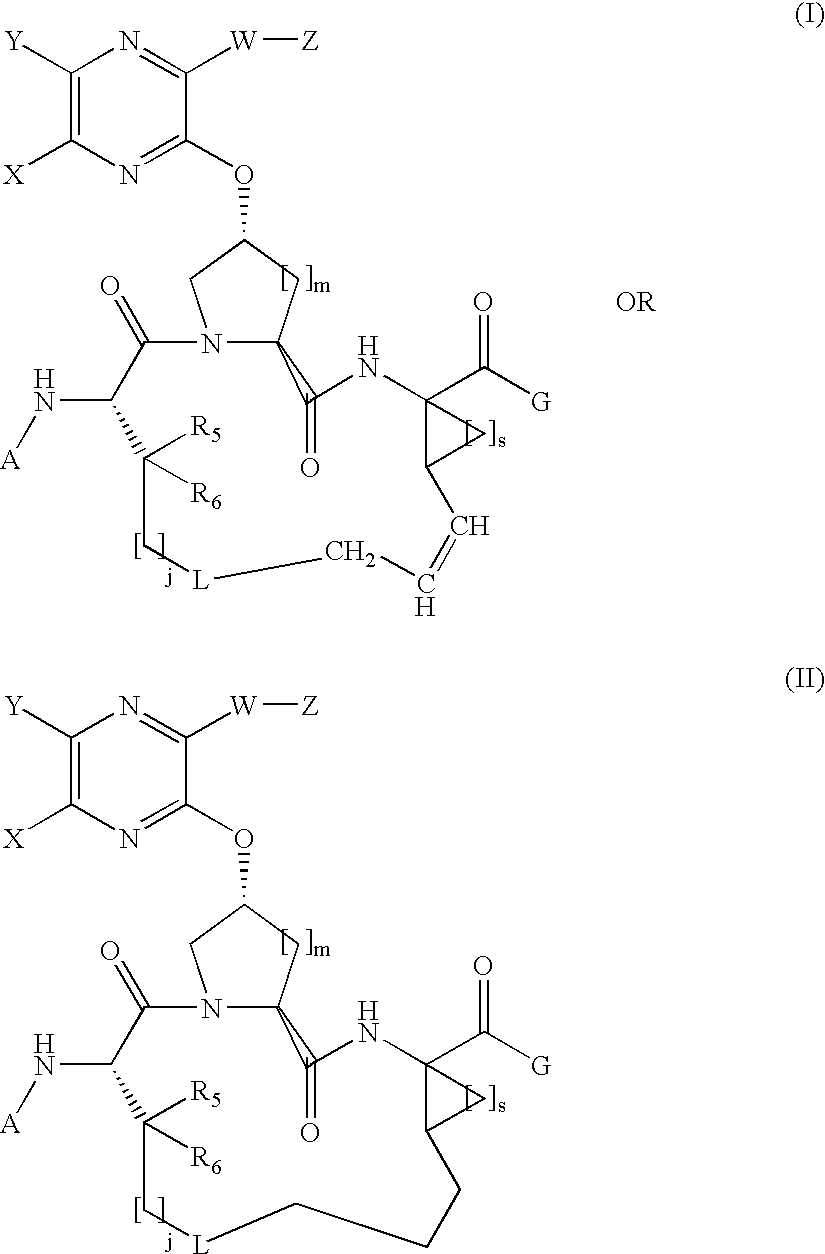Quinoxalinyl macrocyclic hepatitis C serine protease inhibitors
a serine protease inhibitor and quinoxalinyl macrocyclic technology, applied in the field of new drugs, can solve the problems of interferon related side effects, inability to reproduce infectious culture systems and small-animal models for hcv, and increasing public health problems
- Summary
- Abstract
- Description
- Claims
- Application Information
AI Technical Summary
Benefits of technology
Problems solved by technology
Method used
Image
Examples
example 1
[0325]Synthesis of the cyclic peptide precursor
[0326]
[0327]1A. To a solution of Boc-L-2-amino-8-nonenoic acid 1a (1.36 g, 5 mol) and the commercially available cis-L-hydroxyproline methyl ester 1b (1.09 g, 6 mmol) in 15 ml DMF, DIEA (4 ml, 4 eq.) and HATU (4 g, 2 eq) were added. The coupling is carried out at 0° C. over a period of 1 hour. The reaction mixture is diluted with 100 mL EtOAc, and followed by washing with 5% citric acid 2×20 ml, water 2×20 ml, 1M NaHCO3 4×20 ml and brine 2×10 ml, respectively. The organic phase is dried over anhydrous Na2SO4 and then is evaporated, affording the dipeptide 1c (1.91 g, 95.8%) that is identified by HPLC (Retention time=8.9 min, 30–70%, 90% B), and MS (found 421.37, M+Na+).
[0328]1B. The dipeptide 1c (1.91 g) is dissolved in 15 mL of dioxane and 15 mL of 1 N LiOH aqueous solution and the hydrolysis reaction is carried out at room temperature for 4 hours. The reaction mixture is acidified by 5% citric acid and extracted with 100 mL EtOAc, and...
example 2
[0331]Compound of Formula I, wherein A=tBOC, G=OH, L=absent, X and Y taken together with the carbon atoms to which they are attached are phenyl, W is absent, Z=thiophen-2-yl, j=3, m=s=1, and R5=R6=hydrogen.
[0332]Step 2A.
[0333]
[0334]To a cooled mixture of macrocyclic precursor 1,3-(thiophen-2-yl)-1H-quinoxalin-2-one 2a (1.1 equiv.), and triphenylphosphine (2 equiv.) in THF was added DIAD (2 equiv.) dropwise at 0° C. The resulting mixture was held at 0° C. for 15 min. before being warmed to room temperature. After 18 hours, the mixture was concentrated under vacuum and the residue was purified by chromatography eluting with 60% ethyl acetate-hexane to give 2b as a clear oil (35 mg, 99%).
[0335]MS (found): 704.4 (M+H). H1-NMR [CDCl3, δ (ppm)]: 8.6 (d, 1H), 8.0 (d, 1H), 7.8 (d, 1H), 7.6 (m, 2H), 7.5 (d, 2H), 7.2 (t, 1H), 7.0 (brs, 1H), 6.0 (brt, 1H), 5.5 (m, 1H), 5.3 (brd, 1H), 5.2 (t, 1H), 5.0 (m. 1H), 4.6 (brt, 1H), 4.1–4.3 (m, 3H), 3.1 (m, 1H), 5.3 (m, 1H), 2.1–2.3 (m, 2H), 1.3 (brs, ...
example 3
[0340]Compound of Formula I, wherein A=tBOC, G=OH, L=absent, X and Y taken together with the carbon atoms to which they are attached are phenyl, W is absent, Z=2-(formamido)-thiazol-4-yl, j=3, m=s=1, and R5=R6=hydrogen.
[0341]Step 3A.
[0342]
[0343]Commercially available 4-Methoxy-benzene-1,2-diamine 3a (3.6 mmol) and (2-Formylamino-thiazol-4-yl)-oxo-acetic acid ethyl ester 3b (1 equiv.) in ethanol (40 mL) was heated to reflux for 5 hours. After the mixture was cooled to room temperature, the excess ethanol was evaporated in vacuo, and the residue was placed under high vacuum for 2 hours to give compound 3c as a greenish yellow powder.
[0344]MS (found): 303.1 (M+H). H1-NMR [DMSO-d, δ (ppm)]: 8.7 (s, 1H), 8.6 (m, 2H), 7.2–7.3 (m, 4H), 3.8 (s, 3H).
[0345]Step 3B.
[0346]
[0347]To a cooled mixture of 1, quinoxalin-2-one 3c (1.1 equiv.), triphenylphosphine (2 equiv.) in THF was added DIAD (2 equiv.) dropwise at 0° C. The resulting mixture was kept at 0° C. for 15 min. before warming to room temp...
PUM
| Property | Measurement | Unit |
|---|---|---|
| Fraction | aaaaa | aaaaa |
| Fraction | aaaaa | aaaaa |
| Composition | aaaaa | aaaaa |
Abstract
Description
Claims
Application Information
 Login to View More
Login to View More - R&D
- Intellectual Property
- Life Sciences
- Materials
- Tech Scout
- Unparalleled Data Quality
- Higher Quality Content
- 60% Fewer Hallucinations
Browse by: Latest US Patents, China's latest patents, Technical Efficacy Thesaurus, Application Domain, Technology Topic, Popular Technical Reports.
© 2025 PatSnap. All rights reserved.Legal|Privacy policy|Modern Slavery Act Transparency Statement|Sitemap|About US| Contact US: help@patsnap.com



